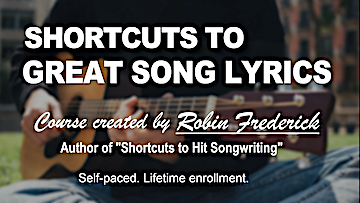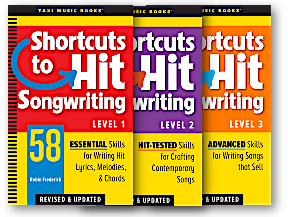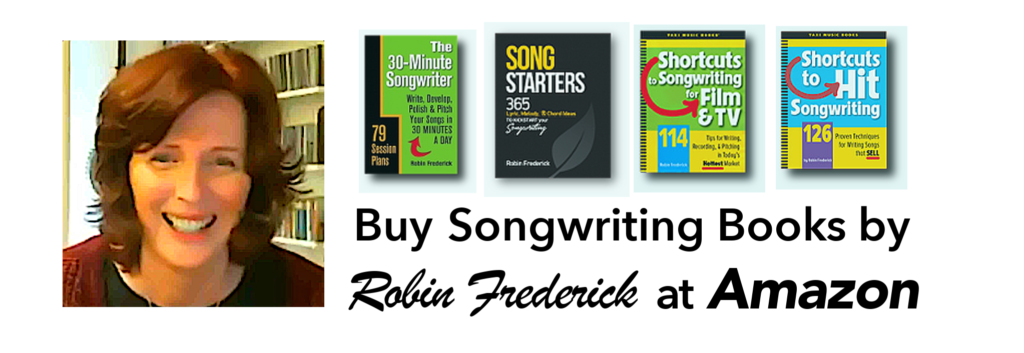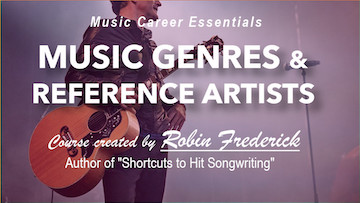Listeners love a good Pop song and radio loves to play them. Whether you want to pitch your songs to established artists in the Pop field or sing them yourself, writing a contemporary, commercial Pop song with hit-single appeal means writing a song that listeners can identify with and radio will want to play.
Pop = Popular
Today’s Top 40 radio format features a wide range of song styles and artists – from Adele to Imagine Dragons. So it can be hard to pin down any specific sound as being “pop.”
Basically, a Pop song is one that a lot of people currently enjoy listening to and want to hear again. It’s literally popular. To reach a lot of listeners – to be popular – a song needs to…
- Move listeners on an emotional level or just make them feel like dancing.
- Have an honest, focused message to deliver.
- Do it in a way that keeps listeners involved and interested.
If a song does these three things, then listeners will usually want to hear it again and that’s what drives a song’s success.
A Pop song is a combination of something you want to say and something listeners want to hear. So, let’s write a Pop song!
Here’s a list of 10 tips with links to more info if you need it. Try not to be critical of work in progress. Just let it flow and see what happens.
1. DECIDE WHAT YOU’LL WRITE ABOUT
Listeners like songs they can understand and identify with. Songs about love relationships (starting up or falling apart), good times, dreams and desires, confronting problems, learning about who we are… these are things that all of us deal with. Here’s a post with a list of themes and song titles you can use.
Whatever your theme, make sure it’s one you want to write about. Your message will emotionally connect with listeners if you handle it with honesty and insight.
Here’s a fun idea: If you don’t have a theme handy and want to get started writing, you can look for ideas in TV shows and movies. They feature the same kinds of popular themes that work for songs. Here’s a post with more info on how to find song themes in TV shows. Just grab a pencil and a sheet of paper and start watching your favorite TV shows.
Once you decide on the basic idea for your song, write out three or four lines that describe who’s involved, what’s happening, and how it feels. Try writing from the point of view of one of the people in the situation. It could be something that happened to you or, if you based your idea on a scene, imagine you’re one of the characters. Most hit Pop songs revolve around the singer or the singer and another person. So use “I” and “you.”
2. GET THE GROOVE GOING
Almost all Pop hits feature a solid, steady rhythm groove. This is how songs connect with listeners in a physical way. A rhythmic groove also expresses the attitude or energy of your song. There are dance grooves, strutting grooves, bluesy grooves, sad grooves, happy ones. Let the groove guide you into your song by suggesting words that match the mood or attitude.
If you play acoustic rhythm guitar, listen to guitar-driven hits by John Mayer or a crossover Country hit by Dan + Shay. Play along with the recording until you can comfortably play the rhythm on your own, then write to it.
If you don’t play an instrument, don’t let that stop you! Try these resources for grooves, chords, and tracks. Pro players can use some of these ideas to get started on a song, then follow up on your own gear.
Once you have a groove, try making a list of short phrases, images, and ideas that the rhythm suggests to you. How does it make you feel? Happy? Sad? Ready for a party? Heartbroken? Yearning? Angry? What kind of situation or relationship does the rhythm suggest? Remember, the music is like underscore for your lyric. Lyric and music need to support each other. Use the lyric writing tips above to get your lyric started.
3. CREATE THE MELODY
The most important thing to remember is that Pop song melodies have a mix of repetition and variation that makes them easy to remember but keeps them fresh enough to be interesting.
Once you have the first line of a melody, try repeating it for the second line. Then go somewhere else for the third line and come back to your original to wrap it up. You can hear this pattern in the verse melody of “Every Breath You Take” buy the Police.
The next thing to remember is that you’ll need one melody for your verse and another for your chorus. Pop radio hits tend to have powerful chorus melodies that let the singer really stretch out and get emotional. Try going to a higher note range for the chorus and give it a peak note – the highest of the song – before coming back down and resolving at the end.
Here’s a helpful tip: Check out some recent Pop hits that you like and notice the pattern of repetition and variation in the chorus melody. Consider using that pattern in your own chorus. Just notice which melody lines repeat and where, and which lines are different. NOTE: The lyrics will often change even though the melody repeats. It’s a great technique to learn and it will be essential when writing Pop choruses.
If you write your melody before your lyric, read this post to find out how to add a lyric to it: How Do You Write Lyrics to a Melody.
4. CHOOSE A CHORD PROGRESSION
Many hit songs use common three- and four-chord progressions. You’re free to use these chords in songs of your own. Just be sure you don’t use any of the vocal melody or lyrics – only the chords.
You can find the chords to your favorite songs in song books and online. Just search for the name of the song followed by the word “chords.” Look up the chords to one of your favorite Pop songs now and write them down.
You’ll find more chord progressions here. Just scroll down the page to the “Chord Progressions” section.
When you have a chord progression you like, try playing it with a rhythm groove, then develop a lyric or melody idea as I described above.
5. BRING YOUR LYRIC THEME TO LIFE
Use dialogue, actions, emotions, and character to make your lyrics come to life. Once you have an idea what you want to write about, try describing it so listeners can see and hear it. Don’t think about rhyming yet.
– Use dialogue. Write your lyric like a script for a movie.
– Write short phrases the use images and action words to describe a feeling.
Be sure to keep your listeners in mind as you write. Remember, a Pop song needs to connect with them in order to succeed. Imagine you’re telling someone about your theme, someone who doesn’t know you very well. What do you think they’d be curious about? What kinds of questions would they want to ask? On a piece of paper, make a list of those questions and write down some short answers to use in your song.


6. GIVE YOUR MELODY AN EXTRA PUSH
Is your melody feeling a little stiff? Have you got a good verse melody but can’t find a chorus that works? Use the natural melody of speech to get going again. By this time you’ve got a lyric theme and some idea of your chorus lyric. Try speaking a line or two with a lot of emotion, then repeat it a couple times with even more emotion. Notice the natural up and down motion and the rhythm of your spoken words. Exaggerate those until you have a melody, then experiment until it feels good to you.
Try these ideas for shaping up your melody.
7. BUILD ON A SONG STRUCTURE
Many of today’s biggest hits are built on the same basic song structure. That doesn’t mean they all stick slavishly to it; there are a lot of ways you can play with it creatively to make it your own.
Here’s the simple skeleton structure on which most hits are built.
VERSE / CHORUS
VERSE / CHORUS
BRIDGE / CHORUS
Those monster radio hits often add a section between the verse and chorus called the pre-chorus. It’s used to build anticipation and excitement leading up to those huge hooky choruses. Pop/Dance hits will sometimes have a section after the chorus called a post-chorus. This is where the music producer gets to show off his or her chops.
If you’re not familiar with hit song structure, this is a good time to listen to a few Pop songs and learn to identify the sections. Here’s a list of recent hit songs I’ve analyzed for you. Choose a Pop song and read about the song’s structure as you listen to it.
Try It Now
Rough out a lyric based on the hit song structure above. Write a first verse lyric that introduces listeners to the singer or the situation. End your verse on a line that leads the listener into your chorus.
Use your most emotional or strongest lyric line to start your chorus. Play your chorus chords and sing the lyric as your work up a melody. Or you can work on melody first, singing dummy lyrics or just “la la” and fill in the lyrics later. Then connect your verse and chorus sections.
You can keep working on your verses and chorus this way until your song begins to take on an overall shape. By using the song structure above, your song will be headed in a commercial, radio-ready direction right from the start.
If you started your song with a melody, try writing a verse melody in a conversational note range, somewhere that’s comfortable to sing without straining. For your chorus, use a higher note range to add emotion. Make sure there’s a clear difference between your verse melody and your chorus melody.
SUGGESTION: As you work on your song, don’t let yourself get bogged down. If you come to a place where you get stuck, just fill in a temporary melody and lyric and keep on going.
Record your rough ideas as you go on a smartphone, computer, or cassette deck—whatever you have handy will do just fine. When you get tired or lose perspective on your work walk away. Then come back later with fresh ears. Listen to your recording and pick up where you left off.

8. REPLACE “BLAH” LYRICS WITH EXCITING ONES
Rewrite and polish
Rewriting can be a real pain in the you-know-what, but it doesn’t have to be. Here’s the trick to making it bearable:
Don’t throw anything away until you have something you like better!
Make it a contest with yourself. Try to beat what you already have. Go through your lyric and look for words and images that have lost their emotional impact through overuse. Try replacing these with words and images that have plenty of emotional associations that fit your theme. If the singer feels trapped in a relationship, consider using words like prison, iron bars, boxed in, tiny room, locks, dark, airless, chains. You get the idea. Do the same with action words. Instead of “walk” try “skip,” “stroll,” “rush,” “slink,” or “melt away.” Make sure the word underscores the character or feeling tone of your theme. Try these tips for creating a compelling emotional experience for listeners.
Be sure to a contemporary edge to your rhymes, too. Today’s big Pop hits rely on “near rhymes” rather than “perfect rhymes” to create a conversational, “I just thought of this” effect. Here’s more info on rhyming in today’s hit songs.
9. FRESHEN UP A POP MELODY
Keep your melody interesting by playing with the rhythm of the notes and lengths of the phrases. Is every line starting on the same beat? Consider moving them so they start a little earlier or later. Or change the length of lines by adding a few words and notes at the end of a line so it runs right into the next. Or break a line into two short phrases.
Here are more ideas for rewriting your melody to make it contemporary and memorable.
10. STRENGTHEN YOUR SONG’S STRUCTURE
Listeners like to feel that a song isn’t wandering around aimlessly, so clarify your song structure by using plenty of contrast between sections.
If your verse has a lot words and a busy, choppy melody, consider smoothing and stretching out the melody in your chorus so listeners can really hear the difference. Think about starting your chorus by jumping up to a higher note than the verses. Give your audience a clue – something they can really hear – that lets them know where they are in the song.
BONUS TIP: REMEMBER TO LISTEN
Be sure to listen to current hit songs you like. These are the kinds of songs the music industry is looking for. And don’t just listen; listen like a songwriter!
Find out more about listening like a songwriter.
When you find a Pop song you like learn to play and sing it. If you don’t play an instrument, then sing along with the record. This is the best and quickest way to begin learning new songwriting habits and give yourself fresh choices when you’re writing.
You won’t be copying these songs. Instead, you’ll be blending these new techniques with your own style to create something fresh and original that works for the that loves current Pop hits!
GET READY TO PITCH YOUR SONGS: Here are tips and resources for you to use when your song is done.


